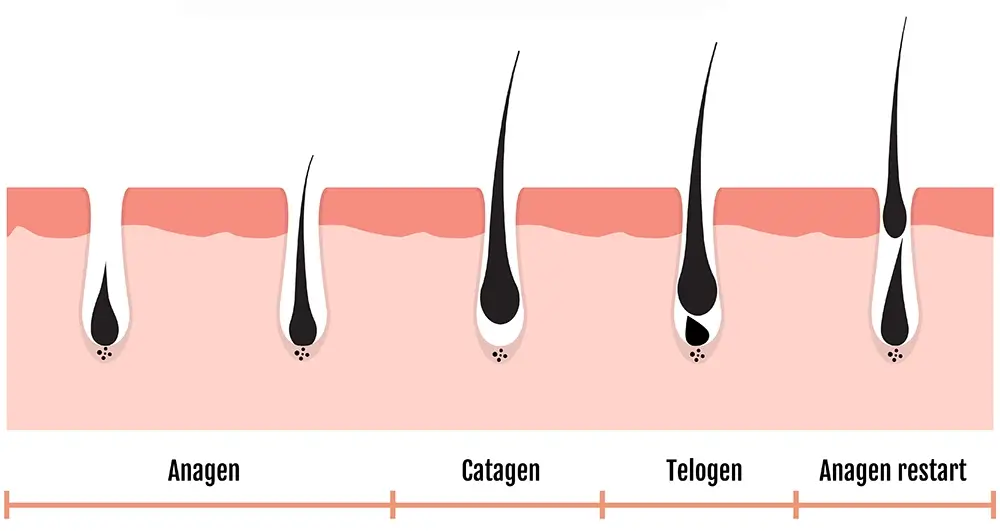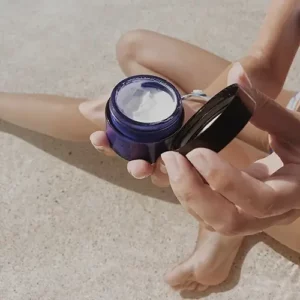
Did you know that hirsutism is an official medical term for unwanted hair growth after puberty in regions commonly found in males? Polycystic ovary syndrome accounts for almost 70% of hirsutism cases! Medication and thyroid disorders can also contribute to unwanted hair, but sometimes nature just means we have more hair than we’d like to keep shaving off.
Have you heard of electrolysis hair removal? While laser hair removal tends to take the spotlight, electrolysis hair removal is another type offered by dermatologists with amazing results to back it.
Luckily, we have put together a complete guide on what electrolysis is, its side effects, and frequently asked questions, so keep reading for more information!
Electrolysis is a technique for hair removal that uses electrical currents to help destroy hair follicles. By damaging these hair follicles, the goal is to prevent future hair growth. Is it a permanent hair removal tactic?
Unfortunately – it depends on individual skin conditions and how many treatments you book (more on that later). Patients who choose electrolysis hair removal include those who:
Electrolysis primarily got its start treating ingrown eyelashes. Yet, it has broadened its use to also include treatments for:
It is an effective treatment that many women (and men) find success with pesky hair removal, and the sessions don’t last very long.

Hair removal strategies have been in place for centuries. Before the 1900s, hair removal started taking a greater hold on society to help reduce lice and parasite infestations.
Hair can also hold bacteria, leading to more odors, and by the time of the turn of the century, hair removal practices had higher societal implications. It was a sign of cleanliness and hygiene. In the 1920s, changes in dresses and clothing inspired more women to start shaving their armpits.
Wax and other techniques are primarily used for women with unwanted facial hair at this time.
Electrolysis has also been around for over a decade, starting in the late 19th century. Since then, it has received Canadian and FDA approval as an effective and permanent hair removal technique. It falls under the second of two categories for hair removal:
Epilation is a hair removal technique that removes the entire hair follicle and shaft, including the bulb. While other treatments can do an excellent job at slowing hair growth, electrolysis has more permanent results.
 Electrolysis disrupts hair growth and, with multiple treatments, stops it completely. A fine wire or probe is inserted into the skin and emits radio wave frequencies. Only a skilled and qualified electrologist should perform this technique.
Electrolysis disrupts hair growth and, with multiple treatments, stops it completely. A fine wire or probe is inserted into the skin and emits radio wave frequencies. Only a skilled and qualified electrologist should perform this technique.
When the direct currents hit the hair follicle, it causes irreparable damage, eventually falling out.
The three main electrolysis types are:
Galvanic uses chemicals that help dissolve hair follicles, while thermolysis uses heat. Some people think that thermolysis is less effective than galvanic, and many electrolysis hair removal clinics use a combination of both. As you can imagine – this process is repeated for every hair follicle in the targeted region.
Electrolysis treatment sessions can range from 15 minutes to one hour. It’s a safe treatment for anyone over 12, but children under 18 will need permission from a parent or guardian.
Like other hair removal techniques, electrolysis has some risks and side effects. Here are some common side effects:
 Untrained electrologists or non-certified cosmetic clinics can put you at risk for skin discoloration, scarring, or infection. You should always go to a trusted, reliable, and certified clinic. Home electrolysis machines are also highly dangerous and can lead to permanent scarring.
Untrained electrologists or non-certified cosmetic clinics can put you at risk for skin discoloration, scarring, or infection. You should always go to a trusted, reliable, and certified clinic. Home electrolysis machines are also highly dangerous and can lead to permanent scarring.
Your dermatologist can give you specific guidelines on cleansers and exfoliators for acne-prone skin or ingrown hairs. Unfortunately, both of these can be more common after electrolysis. But your dermatologist may not want you using harsh products immediately after treatment, so talk to a professional first.
One of the best ways to avoid acne following electrolysis, or in general, is don’t touch your face and use gentle cleansers. Here are some more tips for acne management:
Following these steps will also help your skin stay healthier and younger-looking.
Primarily from the simple fact, that hair grows in stages, and while you may target a hair follicle in its last stage, another one is likely growing underneath. There are four main hair growth stages, including:
Anagen is when it starts growing, catagen is transitionary, telogen indicates resting, and exogen is the final shedding phase. If electrolysis targets a hair follicle during the latter two stages, you might need more treatments for new hair growth.
Each hair follicle could be on a different timeline, making it crucial that you visit an electrologist for more than one visit for the best results. How long do these stages last?
Almost 90% of your hair is in the anagen phase! You will lose approximately 50 to 100 hairs daily during the exogen phase. Not to worry – this is entirely normal and happens to almost everyone.
Hair growth is also affected by region. For example, the pubic and underarm regions have shorter hair growth timelines than scalp hairs. So, while the anagen phase can take three to five years (or longer), every region and person could show slight fluctuations.

Following electrolysis sessions, you should treat it like most of your facial treatment after care instructions. Most facial treatment after care instructions includes hydration, moisturization, and avoiding UV rays.
 Electrolysis is no exception. It is normal to have some side effects for a day or two after treatment, and you should avoid direct sunlight exposure. Avoid any harsh chemicals or makeup immediately afterward.
Electrolysis is no exception. It is normal to have some side effects for a day or two after treatment, and you should avoid direct sunlight exposure. Avoid any harsh chemicals or makeup immediately afterward.
You can ask about special moisturizers or foundation that works well after electrolysis with one a Purlux’s Esthetician. Using high-quality ingredients and products can make a difference in your recovery.
If you notice redness, try using gentle products like ice packs or aloe to help with cooling. Finally, don’t shave or pluck the skin that was treated. When you notice hair growing back, it was likely in the anagen phase. Plucking or shaving it will just delay the process of permanent hair removal.
Instead, schedule another appointment at Purlux for lasting results.
It is not uncommon to want healthy, luscious hair on your head and eliminate hair on your underarms, legs, or bikini area. Unfortunately, no one solution helps hair growth in one region and eliminates it in the other. In addition to electrolysis, you may need some touch-up areas that you can tackle with shaving or more hair removal treatments.
Contrary to popular belief, shaving does not increase hair growth. It also does not make your hair grow thicker, even if it may feel like that.
Shaving cuts off your hair follicle at the skin’s surface. The hair follicle sits in the next layer down (dermis) and is entirely unharmed during this process. That means the blood will continue to supply the roots, eventually growing them back.
That dullness that you may mistake as thickness is actually the blunted edge of the hair follicle shaft cut off. Physical hair removal techniques like waxing or plucking could be more effective in slowing down hair growth.
The hair follicle will have to start growing towards the skin’s surface before poking through, lengthening the time between hair removal. Over time, you may damage hair follicles enough that they stop growing.
But these techniques can also be painful and lead to various unwanted side effects. As you can imagine, these techniques aren’t ideal for hair in the anagen phase. Most experts recommend using laser or electrolysis hair removal for all hair growth stages.
Many understand the process of laser hair removal and waxing. Electrolysis can seem scary and unknown, even though it has been around for decades. Here are some of the top questions people have about electrolysis that can help ease your anxieties.
Electrolysis hair removal is a safe and effective option for hair removal. When you see electrolysis before and after pictures that include scarring or discoloration, the patients likely did not receive an electrolysis treatment at a skilled cosmetic clinic.
Going to a professional makes the difference in safety and outcomes. Electrolysis is the only type of hair removal product that is FDA approved. In North America, it remains a staple in the industry after undergoing rigorous testing.
Electrolysis can cause minimal pain. If you are worried about discomfort, ask your electrolysis Montreal dermatologist about ways to alleviate pain before beginning treatment.
You may notice slight pinching or stinging. For some, electrolysis can be more painful because their facial bones are closer to the skin’s surface.
Before treatment, you can take over-the-counter pain relievers such as Advil or ask about a cooling spray. A cooling spray is often used for many facial cosmetic treatments to help alleviate discomfort during the session.
 Yes – it can be a permanent hair solution if you schedule multiple appointments for weeks to months. As new hair begins growing, it can take up to a year or more for permanent hair removal. It is often compared to laser hair treatments.
Yes – it can be a permanent hair solution if you schedule multiple appointments for weeks to months. As new hair begins growing, it can take up to a year or more for permanent hair removal. It is often compared to laser hair treatments.
Laser hair removal is another highly effective tool, but it usually removes only 50 to 85% of hair. It also requires multiple scheduled sessions and comes with a few more aftercare instructions.
This is a tricky question because it depends on the facial treatment. Chemical peels and microdermabrasion can increase skin sensitivity, and you should avoid combining the two back-to-back.
Most facial treatments are safe to use with electrolysis after a specific time. Talk to your dermatologist about how long to space these two treatments out for the best and safest results.
Electrolysis is different than facial treatments. For example, microdermabrasion cannot be used on everyone.
People with sensitive skin, active rosacea, or deep scarring may not qualify. Chemical peel strengths are also limited to specific skin types.
Electrolysis is not a heavy exfoliator like the two facial treatments mentioned above and is relatively safe for all skin types. Sensitive skin may be more at risk for some of the side effects noted above, but almost anyone can get this treatment.
You may have to stop certain acne medications or treatments beforehand, so talk to your dermatologist about them during your initial consultation.
Have you wondered if electrolysis hair removal is right for you? Maybe you have received other facial treatments or hair removal techniques at a clinic and wonder what restrictions electrolysis has.
Luckily, it is safe for many individuals (even those under 18), quick, and effective. If you want long-term hair removal, even one treatment can help do the trick.
The characteristic that sets electrolysis apart from other hair removal techniques is that it can permanently remove unwanted hairs if performed correctly and consistently. Are you ready to start your journey?
Book an appointment now at Purlux!